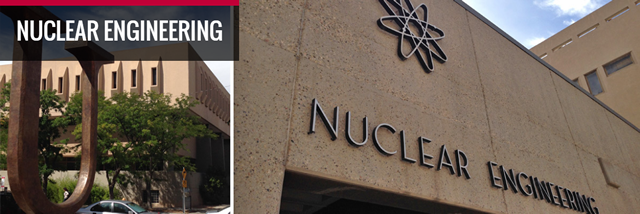
Nuclear Engineering ETDs
Coupled Radiation Transport / Thermal Analysis of the Radiation Shield for a Space Nuclear Retractor
Publication Date
5-20-1985
Abstract
The renewed interest of conducting operations in space has given rise to re-establishment of space reactor systems development. The current SP-100 program is focussing on design of a 100 kW nuclear e reactor for space application. This research project investigated the coupling between radiation transport, energy deposition, and temperature distribution for a variety of space reactor shield configurations. The basic shield design consisted of tungsten [W], and natural lithium hydride either cast or pressed into a stainless steel matrix [LiH(Nat)].
For a nuclear reactor operating at a power level of 1.66 MWth, temperature feedback effects on energy deposition in the shield were examined for a shield consisting of 4 cm of W, followed by 71 cm of LiH(Nat). Using the free gas differential scattering kernel, the temperature dependent thermal neutron cross sections (including upscatter) were generated for the non-Maxwellian neutron distribution in LiH(Nat). The calculations showed that the total energy deposited in the shield decreased by only 2.5% when temperature dependent number densities and thermal neutron cross sections were included in the analysis. Considering the temperature effects only on the number densities, while neglecting temperature effects on the thermal neutron cross sections, resulted in a decrease of 5.9% in total energy deposition throughout the shield. The maximuM change in temperature was about 1.5%, which leads to the conclusion that temperature feedback effects on energy deposition in the shield are not significant for SP-100 power levels.
The effects of shield configuration on energy deposition were shown to be a critical design consideration. Layered shields consisting of depleted lithium hydride [LiH(Depl)] followed by LiH(Nat) were compared with all natural LiH shields, with W either at the front of the shield or moved 13.4 cm into the shield. The movement of W into the shield was made to reduce the generation of secondary gammas. The impact on temperature distribution of LiH(Depl) was much greater for the configuration of W moved into the shield. With the substitution of LiH(Nat) with LiH(Depl) over part of the shield, the maximum LiH temperature was reduced from 772 K to 680 K when W was placed at the front of the shield, and reduced from 1074 K to 714 K with the W located 13.4 cm into the shield. The significant difference was mainly due to the relative contribution of the highly thermally conductive W to heat removal from the hot portion of the shield to the radiative outer surface.
With these results, a final design modification of the SP-100 shield was made to include a 2 cm graphite disk at the front of the shield. This passively cooled graphite, LiH(Depl), W, LiH(Nat) shield maintained a temperature profile below the 680 Kupper temperature limit of LiH throughout the entire shield. An analysis of the thermal stresses in the shield was made with the LiH and graphite modelled as bilinear, orthotropic materials, and Was an isotropic material. Calculations showed extremely large tensile stresses at the outer radial surface of the shield when this surface was free to expand. When this surface was pinned (corresponding to perfect contact between the LiH and its outer casing), the stress distribution throughout the shield was predominantly compressive. These results showed the importance of limiting the movement of the LiH at the outer radial surface, to prevent excessive tensile cracking.
The results of this research show that a shield optimized for radiation protection may fail due to thermal melting. Hence, thermal design considerations must be given the same priority as radiation protection for a shield using LiH at the power levels of the SP-100 reactor system.
- Bilinear, Orthotropic Material
- Composite Cylinders Model
- Energy Deposition
- Finite Element Method
- Free Gas Scattering Kernel
- Galerkin Projection
- Newton-Raphson Iteration
- Radiative Heat Transfer
- Radiation Transport
- Reactor Shielding
- Space Reactor
Sponsors
U.S. Department of Energy and Sandia National Laboratory
Document Type
Dissertation
Language
English
Degree Name
Nuclear Engineering
Level of Degree
Doctoral
Department Name
Nuclear Engineering
First Committee Member (Chair)
Mohamed S. El-Genk
Second Committee Member
Patrick J. McDaniel
Third Committee Member
James Lee
Fourth Committee Member
Norman Roderick
Fifth Committee Member
Howard Schreyer
Recommended Citation
Barattino, William John. "Coupled Radiation Transport / Thermal Analysis of the Radiation Shield for a Space Nuclear Retractor." (1985). https://digitalrepository.unm.edu/ne_etds/85

Comments
The sixth committee member is Roy Johnson.